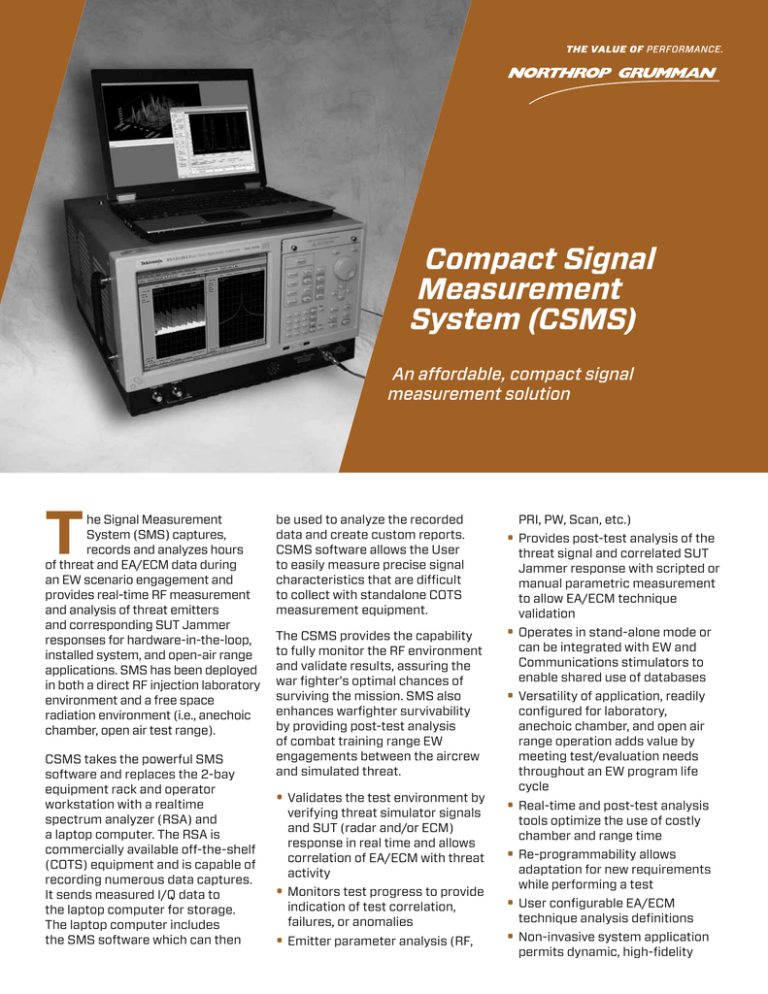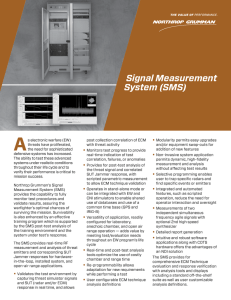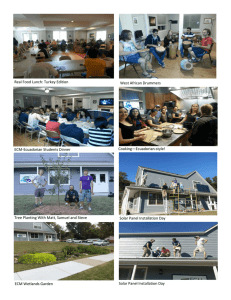Compact Signal Measurement System (CSMS)
advertisement

Compact Signal Measurement System (CSMS) An affordable, compact signal measurement solution T he Signal Measurement System (SMS) captures, records and analyzes hours of threat and EA/ECM data during an EW scenario engagement and provides real-time RF measurement and analysis of threat emitters and corresponding SUT Jammer responses for hardware-in-the-loop, installed system, and open-air range applications. SMS has been deployed in both a direct RF injection laboratory environment and a free space radiation environment (i.e., anechoic chamber, open air test range). CSMS takes the powerful SMS software and replaces the 2-bay equipment rack and operator workstation with a realtime spectrum analyzer (RSA) and a laptop computer. The RSA is commercially available off-the-shelf (COTS) equipment and is capable of recording numerous data captures. It sends measured I/Q data to the laptop computer for storage. The laptop computer includes the SMS software which can then be used to analyze the recorded data and create custom reports. CSMS software allows the User to easily measure precise signal characteristics that are difficult to collect with standalone COTS measurement equipment. The CSMS provides the capability to fully monitor the RF environment and validate results, assuring the war fighter’s optimal chances of surviving the mission. SMS also enhances warfighter survivability by providing post-test analysis of combat training range EW engagements between the aircrew and simulated threat. • Validates the test environment by verifying threat simulator signals and SUT (radar and/or ECM) response in real time and allows correlation of EA/ECM with threat activity • Monitors test progress to provide indication of test correlation, failures, or anomalies • Emitter parameter analysis (RF, PRI, PW, Scan, etc.) • Provides post-test analysis of the threat signal and correlated SUT Jammer response with scripted or manual parametric measurement to allow EA/ECM technique validation • Operates in stand-alone mode or can be integrated with EW and Communications stimulators to enable shared use of databases • Versatility of application, readily configured for laboratory, anechoic chamber, and open air range operation adds value by meeting test/evaluation needs throughout an EW program life cycle • Real-time and post-test analysis tools optimize the use of costly chamber and range time • Re-programmability allows adaptation for new requirements while performing a test • User configurable EA/ECM technique analysis definitions • Non-invasive system application permits dynamic, high-fidelity measurement, and analysis without affecting test results • Selective programming enables user to collect & analyze specific radars and find specific events or emitters • Integrated and automated features such as scripted operation reduce the need for operator interaction and oversight • Detailed report generation • Intuitive and robust software applications along with COTS hardware offers the advantages of an Non-Development Item (NDI) solution • When combined with a CEESIM, • Coordinated RGPO (CRGPO) • Multiple Doppler • Noise (Doppler, Range Gated, CW, • False Targets (Multiplexed and provides a complete end-to-end test capability for EA/ECM jammer systems. It verifies emitters from the threat simulator and correlates/verifies the EA/ECM responses from the SUT ECM Measured Techniques • Range Gate Pull Off (RGPO) • Swept RF • Velocity Gate Pull Off (VGPO) • Swept Square Wave Coordinated) Spot, Barrage, Swept, Cover Pulse) Measured Parameters Parameter Measurement Range Measurement Accuracy Measurement Resolution Frequency 20 MHz to 20 GHz 150 Hz RMS, coherent signals ±5 kHz (single pulse) ±300 Hz (average, 100 pulses) 10 Hz Bandwidth 0 to 500 MHz ±10%, ±1 kHz minimum 300 Hz RMS, coherent signals 1% of span Pulse Width 100 ns to 65 ms ±20 ns 5 ns PRI 500 ns to CW 1 ns RMS (250 pulses) 5 ns Amplitude Dynamic Range 2.5 dB absolute, 1.0 dB relative 0.1 dB TOA Data Collection 50 ns 5 ns SMS Features and Characteristics SUT and Threat Simulator Input Frequency Ranges • 20 MHz to 20 GHz (upgrade to extend range to 40 GHz) Instantaneous Bandwidth • 10 MHz and 110 MHz Recording Size • Configurable up to 16 TB+ Analysis Display Formats • Amplitude • Frequency • Frequency Shift • Pulse Width • Pulse Repetition Interval (PRI) • Intrapulse Modulation (Amplitude, Frequency or Phase) www.northropgrumman.com Specifications and features subject to change without notice. © 2013 Northrop Grumman Systems Corporation All rights reserved. DS-462-TLK-0113 A330: 13-1247 DSEA: 2013 RM Graphics • Spectrum Plot • Spectrum Waterfall Plot (3-D) • Frequency Shift Histogram • Delay Time Histogram • Pulse Frequency Histogram • RGPO, VGPO and CRGPO All Data Archived for Post Test Analysis Report Generator • User customizable reports available in .pdf format Closely Coupled with CEESIM and AMES RF Simulators • Scripted Scenario Control for Correlation of SUT Response to Threat Emitter Tuning Speed • < 100 ms External Control • Ethernet 10/100/1000 Base Tx For more information, please contact: Northrop Grumman Corporation Amherst Systems 1740 Wehrle Drive Buffalo, New York 14221-7032 USA e-mail: amherstsolutions@ngc.com






